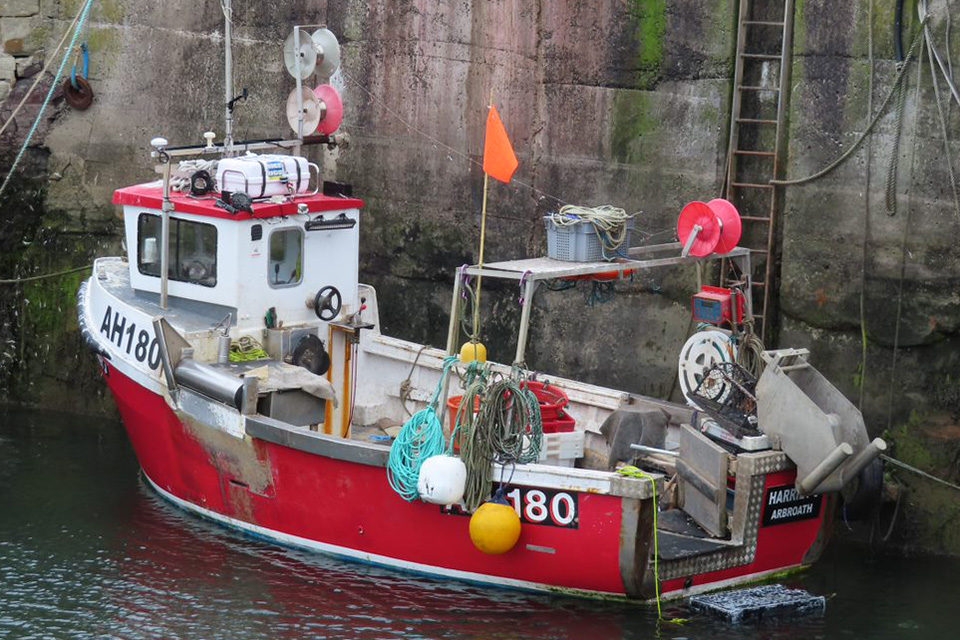Safety flyer to the fishing industry - Harriet J
Published 22 June 2023
1. Summary
Fatal man overboard from the lone-operated creel fishing vessel Harriet J (AH180) west of Fast Castle Head, south-east Scotland, on 28 August 2021

Harriet J
2. Narrative
In the early hours of 28 August 2021, the lone-operated creel fishing vessel Harriet J left St Abbs, Scotland, accompanied by two other fishing boats. The three vessels proceeded west around St Abbs Head and along the coast towards Siccar Point where Harriet J started working creels to the west of the bay.
At about 0730, the skipper finished hauling the fourth fleet of the morning and reversed Harriet J’s course ready for shooting; the vessel settled on a heading of 095° at a speed of 5.4 knots over the ground. The skipper shot the fishing gear through Harriet J’s shooting door when the vessel was aligned with the previous position where the fleet had been laid.
It appears that, at 0736, the skipper was pulled through the shooting door and into the water; it is likely that his right foot was caught in the fishing gear while he was attempting to clear a snag during the shooting operation. With the throttle set, Harriet J continued on its course. The skipper of one of the accompanying fishing boats noticed the advancing Harriet J and attempted to contact its skipper by very high frequency radio but received no response. He was concerned by the behaviour and heading of the vessel and set off in pursuit, raising the alarm as he did so. Once he had manoeuvred alongside Harriet J, his crew member boarded the vessel and discovered that it was unmanned.
The alarm was raised and Aberdeen Coastguard launched an extensive search and rescue operation involving several assets and local vessels. At about 0900, Harriet J’s skipper was recovered from the sea and, at 0906, transferred to a rescue helicopter. He was taken to Edinburgh Royal Infirmary but declared deceased less than an hour later.
The MAIB investigation found that Harriet J motored away from the skipper after he was pulled into the sea, and so he was unable to reboard the vessel. The skipper was neither wearing a personal flotation device (PFD) nor carrying a personal locator beacon (PLB), despite Harriet J being equipped with both, and he succumbed in the water before he could be found.
In the 5 years before this accident there have been eight fatal accidents involving UK fishing vessels under 15m in length where a person went overboard. Of these, four were lone-operated boats and four were the result of entanglement in the gear. All were creel (or potting) vessels. Only one of the fishers who died was wearing a PFD and none was carrying a PLB.
3. Safety Lessons
-
There was no means of separating the skipper from the fishing gear on the deck of Harriet J. Although a pound board ran along the starboard side of the working deck, the equipment stowed behind it meant that it was impossible for the skipper to access the deck without placing himself near to the fishing gear. The presence of an effective physical barrier between the skipper and the gear would have helped him to stay safe while shooting the gear and clearing any snags.
-
The skipper was working alone on deck without a PFD. Once he entered the water, he had no means to help him stop the boat, assist him to get back on board or remain afloat. Without any additional buoyancy in the cold water, the likelihood of his survival was significantly reduced.
-
An activated PLB quickly initiates a search, enables rescuers to focus their search and improves the chances of finding someone in the water. In this case, the alarm was raised relatively quickly from a nearby boat, but it still took more than an hour to find the skipper in the water.
-
Lone fishing is a high-risk profession that continues to cause fatalities. Publications such as the Maritime and Coastguard Agency’s Fishermen’s Safety Guide and Single handed fishing guide provide invaluable information on how fishers can prepare risk assessments and deal with the hazards they face. Further guidance is also available on the FISG Home and Dry safety campaign website.
Extract from The United Kingdom Merchant Shipping (Accident Reporting and Investigation) Regulations 2012 – Regulation 5:
The sole objective of the investigation of an accident under the Merchant Shipping (Accident Reporting and Investigation) Regulations 2012 shall be the prevention of future accidents through the ascertainment of its causes and circumstances. It shall not be the purpose of an such investigation to determine liability nor, except so far as is necessary to achieve its objective, to apportion blame.
Note:
This safety flyer is not written with litigation in mind and, pursuant to Regulation 14(14) of the Merchant Shipping (Accident Reporting and Investigation) Regulations 2012, shall be inadmissible in any judicial proceedings whose purpose, or one of whose purposes is to attribute or apportion liability or blame.
Marine Accident Investigation Branch
First Floor, Spring Place
105 Commercial Road
Southampton
SO15 1GH
Email [email protected]
Enquiries during office hours +44 (0)23 8039 5500

